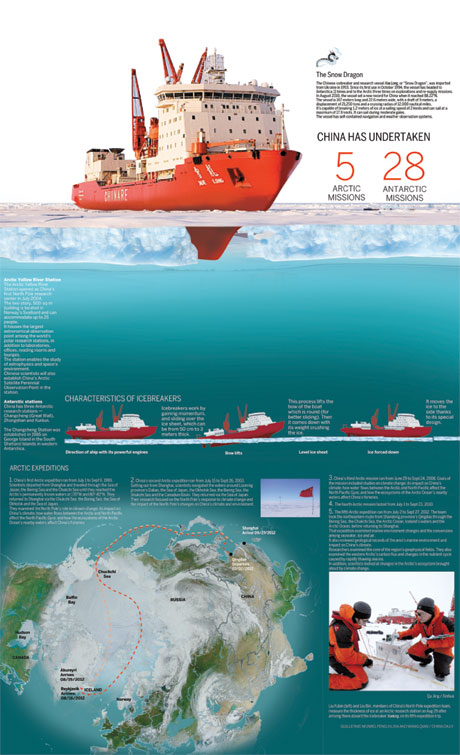Breaking the ice
Updated: 2012-09-30 08:07
By Wang Qian(China Daily)
|
|||||||
Arctic melting creates new opportunities that China must cooperate with other countries to seize. Wang Qian reports.
China's fifth Arctic expedition team suggested the country enhance cooperation with Arctic countries to expand its research of Earth's northernmost region.
During the more than 80 days of expedition that started in July, the Chinese icebreaker Xuelong (Ice Dragon) sailed the Northern Sea Route, also called the Northeast Passage. It was escorted by the Russian nuclear icebreaker Vaygach, and both vessels returned via what will become the Central Arctic Shipping Route.
Most of the melting Arctic's coastline belongs to Russia and Canada. The Northern Sea Route stretches along the crown of Russia from the Atlantic to the Pacific. It has become seasonally ice-free because of climate change.
Russia considers the route to be within its waters in accordance with the 1984 United Nations Convention on the Law of the Sea. Consequently, Russian vessels must escort foreign ships.
This is just one of many dimensions of the cooperation China must engage in to expand its Arctic research.
The convention states no country owns the North Pole or the region of the Arctic Ocean surrounding it.
The warming waters are creating shorter shipping routes and unlocking potential energy resources, such as undersea oil and gas fields.
Consequently, there is a race to become a leader in Arctic exploration and research.
A quarter of the world's undiscovered oil and gas resources are believed to be in the Arctic.
The National Snow and Ice Data Center at the University of Colorado reported that Arctic sea ice cover melted to its lowest extent in the satellite record on Aug 26 and continues to drop. It was fewer than 4 million square kilometers in mid-September. The melt season typically ends in the second week of September.
Polar Research Institute of China Deputy Director Li Bingrui said the new shipping routes created by the melting ice will cut shipping costs between Europe and Asia.
The receding of the ice cap surrounding the North Pole could open up three routes - the Northwest Passage, crossing the Canadian Arctic; the Northeast Passage, running from Murmansk, Russia, to the Bering Strait; and the Central Arctic Shipping Route, which will run through the North Pole.
"(The central route) will be about 5,846 nautical miles (11,000 km) shorter through the Northeast Passage from Shanghai to Murmansk than the current shipping lane," Li said.
The Russian vessel Monchegorsk, which is owned by Norilsk Nickel, took about 20 days to traverse the Northern Sea Route from Murmansk through the harbor town of Dudinka on the Taimyr Peninsula to Shanghai in 2010. The trip would take 60-65 days along the traditional route via the Suez Canal.
Parts of the shipping lane are free of ice for about two months - generally, August and September - in the melt season every year.
Many believe the Central Arctic Shipping Route is the most feasible Arctic shipping route. It is the shortest way through the central Arctic Ocean, the passage through which depends on dramatic reductions of North Pole ice thickness.
Scientists predict that, if the sea ice continues to melt, icebreakers could navigate central Arctic waters before 2020.
Contact the writer at wangqian@chinadaily.com.cn.

(China Daily 09/30/2012 page7)